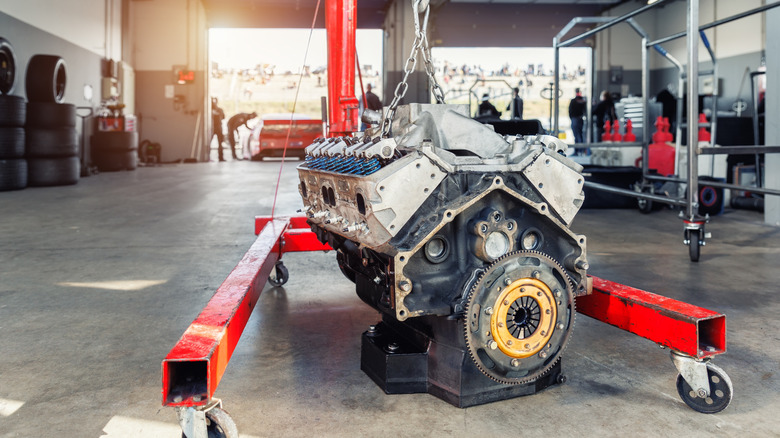Are Magnesium Engine Blocks Any Good? A Look At The Pros & Cons Involved
Magnesium has found use in the broader automotive industry since the 1920s for a variety of applications, ranging from chassis to powertrain construction. Many vehicles utilize magnesium and its alloys due to the element's light weight, helping to shift a car's center of gravity, lower overall mass, and subsequently improve handling characteristics and balance. Moreover, magnesium offers additional strength and vibration benefits over steel components, seemingly useful in high-weight applications like engine parts.
However, all of these benefits come at a cost, and for magnesium, that cost is tangible and substantial. Magnesium costs approximately 80% more than typical carbon steel, and materials aren't as universally mass-produced because of a lower overall demand in the automotive sector. As such, engine blocks utilizing magnesium in their construction are generally less common and more specialized (with some exceptions) and are more expensive to produce.
Engine blocks boast numerous benefits from magnesium alloys due to their overall weight savings versus cast iron or even aluminum blocks, like many of GM's LS engines. A magnesium engine block is approximately 50 percent lighter than a cast-iron block and 30 percent lighter than one in aluminum, leading to improved weight savings without sacrificing the block's natural stiffness when alloyed with other metals. But is it actually a miracle material, or is there a reason why surprisingly few vehicles on the road and racing circuit use magnesium engine blocks?
Anatomy of the magnesium engine block
Before anything, first let's take a look at what exactly engine blocks must do. At an obvious baseline level, an engine block contains most major components of the lower portion of an engine, such as the pistons, crankshaft, camshaft and pushrods in an overhead-valve car. These components are bathed in oil and must be cooled in some way because of the tight tolerances involved, leading to metal-on-metal friction without some sort of protective film.
All of these components generate tremendous forces when the vehicle is operating, including the momentum of the reciprocating pistons, the weight of the spinning crankshaft, and so on. As such, an engine block must necessarily feature certain levels of material strength that can accommodate these forces. Materials that are too brittle or have improper thermal conductivity may crack, and materials that are too soft will warp. That's why many engine blocks use cast-iron construction; they afford the best levels of structural strength for the cost, though they're naturally substantially heavier than other materials.
Magnesium, as an element, burns far too easily to be used in construction, a particular problem considering engine oil can catch fire, for instance. Consequently, manufacturers utilize a variety of magnesium alloys to construct engine blocks. Modern alloy compositions allow for elevated temperatures and precision sand casting that are comparable to aluminum alloys, aiming to marry the benefits of both. The specific compositions of these magnesium alloys continuously vary and are usually trade secrets, but they usually feature metals like zinc and zirconium.
What cars feature magnesium engine blocks?
Given the cost-benefit analysis, it may be surprising that the car with the longest continuous production in the world used a magnesium alloy engine block: the original Volkswagen Type 1 Beetle. Faced with the challenge of building a car with such a massive weight behind the rear axle, Volkswagen opted to cast its engine blocks from magnesium alloys sourced internationally, such as a rebuilt facility in southern Norway. Volkswagen ended up purchasing some 60 percent of the Herøya plant's magnesium production between 1950 and 1990 to use in its vehicles, with the biggest contributor being the air-cooled flat-four engine block. The only other major manufacturer today utilizing a magnesium engine block is BMW, which introduced the first mass-produced water-cooled partial magnesium-alloy engine block in 2005.
Modern remanufacturers still use magnesium alloy-construction engine blocks, in addition to reproduction aluminum units, each with its own benefits and drawbacks. Similarly, classic air-cooled Porsches also use magnesium, with Porsche even offering new factory-made magnesium blocks for restoration of various Carrera engine displacements from 2.0L to 2.7L.
Various manufacturers today utilize magnesium in a number of ways, though seldom for engine parts. For example, GF Casting Solutions AG produces magnesium alloy structural body elements for the modern Land Rover Defender, such as the cross-beam forming the upper portion of the front of the cockpit where the instrumentation and dashboard are mounted. Typically, magnesium is associated with more luxury brands like Porsche, Audi, and Mercedes-Benz, but Ford actually uses a substantial amount as well. For example, Ford utilized magnesium components in every F-150 generation since 2004, such as front-end structures and seat frames.
Benefits of magnesium engine blocks
The main draw of Volkswagen's air-cooled magnesium engine block still applies today, though in different ways. The reason behind Volkswagen's decision was that the Beetle houses all its major components in the rear, making the car potentially unstable. No modern mass-produced cars feature such a prominent weight bias, though balance remains paramount to overall handling characteristics. A vehicle with more front-bias will naturally prefer understeer; likewise, it'll oversteer with rear weight bias. This also factors into why cars are front, mid, or rear-engined. Because magnesium is so much lighter than other metals, replacing certain components with magnesium parts not only lightens a vehicle but may also redistribute its balance for better handling.
Magnesium offers additional benefits besides weight, however. For example, magnesium alloys are exceptionally easy to cast, meaning it's easy to produce complex one-piece structures. They also have excellent noise and vibration-damping properties and provide outstanding thermal stability. This means that magnesium parts will retain their shape longer when subjected to high temperature differences, such as those experienced during multiple cold starts and air-cooled applications, like the Volkswagen. All of this ties in with its strength/weight ratio; you don't need as much material in constructing a magnesium engine block because the alloy itself is strong, further reinforcing its already low weight. Altogether, this makes a magnesium engine block just as strong as comparable alloys while being lighter, with improved secondary characteristics such as noise dampening, and potentially improved longevity under high-demand loads with lots of heat present.
Drawbacks of magnesium engine blocks
All this makes magnesium sound like a miracle material for large components like engine blocks. So why doesn't every manufacturer utilize more magnesium?
The two main reasons are cost and availability. An engine block is one of the most material-intensive components in a modern car; it needs a lot of material, and that material must be tightly toleranced to produce consistent performance. Magnesium excels at this, but building the engine blocks is more costly than machining a cast-iron block to the same standards due to magnesium's complex extraction and mining processes. Magnesium also corrodes and ignites more readily than other materials, meaning the complexity of producing high-quality alloys that can operate within the heat range of modern engines and cope with factors like corrosive road salt is greater, though it's less of an issue with alternatives to the usual salt for melting snow. That's why BMW's straight-six only uses magnesium in parts where corrosion and high stresses aren't major concerns.
As for availability, China produces 87 percent of the world's magnesium used for manufacturing, with much of that eaten by electronics. Following the Pandemic and various tariffs, the amount of imported magnesium is dwindling and more costly. Additionally, more industries worldwide utilize magnesium in the production of aluminum alloys, all of which have compounded to create an ongoing international material shortage. Europe and North America use approximately 19 percent of worldwide magnesium production for bespoke components and 40 percent for aluminum alloys, meaning these particular industries suffered most heavily. As such, while it'd certainly be nice to assemble heavier parts from magnesium, there's simply not enough to produce these parts in the first place.
Where you're most likely to find magnesium engine blocks
Today, a magnesium engine block is generally regarded as a more specialized component, and it's priced accordingly. Most cars utilize magnesium to save weight and improve fuel efficiency, not to improve performance. Nevertheless, race cars have utilized magnesium parts for over a century, though the material often proved deadly rather than beneficial. For example, the 1968 Honda RA302 Formula One car utilized an air-cooled engine and magnesium-skinned chassis to save weight. When it crashed in the 1968 French Grand Prix, the entire bodywork combusted at once due to magnesium's properties, costing driver Jo Schlesser his life. Today, the car is known as one of the world's deadliest race cars ever.
As for engine blocks, a few infamous machines utilized magnesium outside of Volkswagens and Porsches, some of which are truly obscure and bizarre. For example, the 1955 Moto Guzzi Otto Cilindri (Italian for "Eight Cylinders") motorcycle uses likely one of the smallest functional V8s ever produced for serious applications — and yes, its block is magnesium.
Specific alloys implemented in powertrains today have been in development since the early 2000s and help mitigate these concerns and utilize magnesium's inherent strengths. While no major manufacturer produces magnesium engine blocks in standard-production cars and motorcycles, it's slowly becoming a popular option for motorsports applications, particularly when used in alloys such as in NASCAR engines, which are composed of a cast-iron and magnesium alloy. Considering how much power NASCAR engines produce, that itself stands as testament to the efficacy of magnesium in racing.





